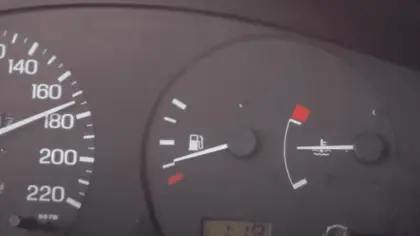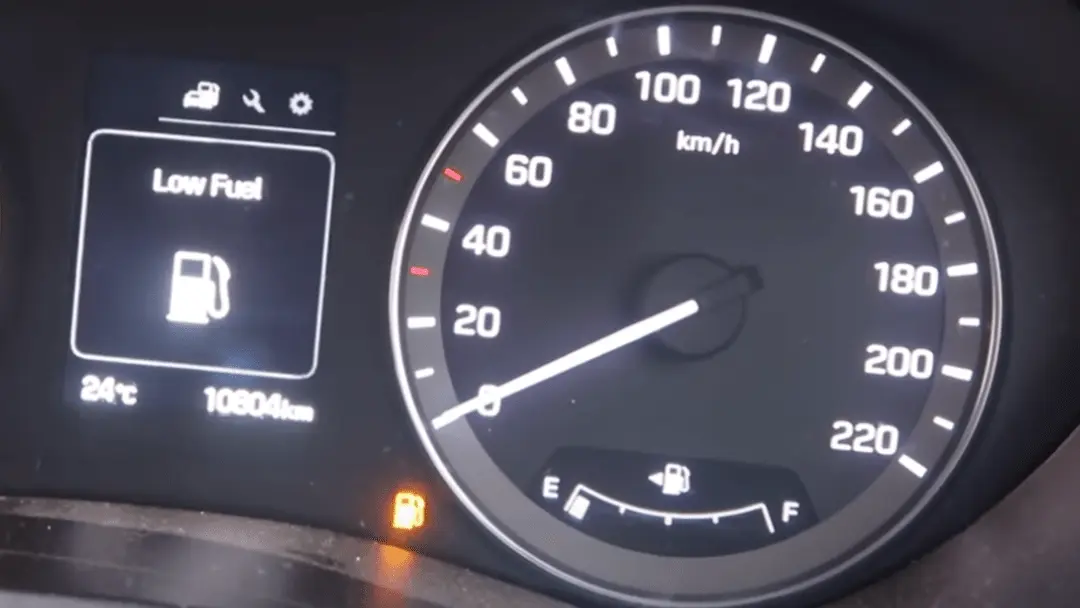An active low fuel light doesn’t always mean it’s time to take the car to a gas station, as sometimes you may need to visit an auto repair shop. The car’s low fuel light comes on when tank is full indicates a malfunction of the fuel gauge or fuel level sensor. Though it’s not a seriously concerning issue, you can ignore this annoying light for a while.
Instead, let’s understand the most obvious reason why the low fuel light comes on when the tank is full and use simple tips to fix it.
Low Fuel Light Comes on when Tank is full

When the fuel gauge falls below one gallon, the light flashes. If the solid light illuminates, it means there is only half a gallon remaining. But what if the low fuel light comes on when the tank is full? It’s obviously a sign of a system malfunction or the use of faulty parts.
Also Read: Battery And Brake Light Flashing
Stuck Float
If the tank is full and the vehicle continues to flash, it could be due to a stuck tank-level float. The float can get stuck due to storing the vehicle with a partially empty tank, particularly in the winter. While you can keep driving, as the float should be unstuck eventually and start functioning properly, it’s better to pull the fuel pump and clear the float.
In this case, unplug the fuel unit connector and inspect if the light turns off. If it works, it means that the level unit, such as a float or sender, has been damaged and is no longer functioning properly. But if the light still turns on, possibly the wiring harness or cluster has gone bad.
Fuel Level Sensor
A car light may stay on when the fuel tank is full due to the faulty fuel level. To avoid this problem, the best recommendation is to use high-grade fuel. Usually, lower-grade fuel contains more impurities or traces of water that can damage the sensor.
Low-quality gasoline can also damage the car’s metal parts, like fuel sensors, thin prongs, and needles. The water in the cheap gasoline can cause corrosion to build up in the metal parts.
To fix the problem, take the car to a mechanic. He’ll check the sensor and clean or replace it. In most cases, replacing the fuel sensor costs around $200 to $300, which varies based on the make and model of the car. If you want to cut down on the cost, buy the part for $50 to $200 and replace it yourself. However, the mechanic will inspect the whole fuel tank system for defects and help avoid causing further damage.
Damaged Variable Resistor
It consists of a metal needle and variable resistance board, and corrosion can dull and wear down the tiny metal lines on the needle. The variable resistor can also get damaged due to the age or use of low-grade fuel additives.
If the lines on the needle rust excessively, it might not be able to function properly to send the correct reading to the fuel gauge. As a result, the low fuel light comes on when the tank is full.
Incorrect Gas Gauge Reading
Suppose you filled up the tank a week ago and drove regularly. You can’t expect improved fuel efficiency all the time. The vehicle can get incorrect gas gauge readings due to a problem with the variable resistor. Possibly a faulty open circuit in the resistor, faulty wiring, or a bad gauge is causing the error.
Another reason for the cars getting the wrong gas gauge reading and turning on the fuel light with a full tank is stuck the gauge on empty. Possibly the floats get disconnected from the metal arms and can’t send the right information about fuel level. A malfunctioning variable sensor or corroded wires in the system can also be the root of the problem.
In addition, if you play a guessing game while attempting to figure out the amount of fuel in the tank, it can cause the float to stick in place and jolt back into motion due to the movement of the vehicle. It can also introduce irregular readings, and coming out with the low fuel light when the tank is full is the most potential one. Whatever the reason is, you need a technician instead of a DIY fix.
Also Read: How To Read A Dipstick With Dots
Blocked Fuel tank ventilation hole
The ventilation hole at the top of a fuel tank can get blocked, which can then shrink the fiberglass tank. It can also bend the metal needle between the variable resistance and the float and disturb the movement across the variable resistance board.
As a result, the sensor may fail and won’t be able to deliver the correct reading to the fuel gauge, and you may experience confusing consequences. To avoid this hassle, check the fuel level sensor regularly so the tiny hole on the fuel tank’s top doesn’t get blocked due to dirt or debris. If it already happens, you may need to change the fuel tank cover.
How to Reset Low Fuel Light?

The simplest and best way to reset the low fuel light is by filling the tank. In general, the low fuel light turns on when the fuel level drops below 10% of the tank’s capacity. It means the vehicle has only 30 to 50 kilometers left before sucking air along with debris, which can lead to clogging the fuel filter.
Since your car’s tank is already full, you have to try something alternative, like putting a little piece of electrical tape over the light. The electrical tape will prevent light from passing through it; hence, you’ll only see a dim glow around the corners. Another option is to turn off the light. However, it won’t be worth the trouble if your car was manufactured in the past 12 to 15 years.
Regardless, if you have an older model car, read the repair manual to determine which color of power wire is powering your fuel warning light and then cut it.
Another thing to do is remove the instrument panel and find the right power wire for the light and cut it. Then tape the end of the power wire to avoid causing a short circuit. It’s recommended and safe to use electrical tape on the dash panel instead of the power wire.
Some car owners also use Sharpie markers to tone down the obnoxious light in the dash panel, which still makes the light visible but is less annoying. The effortless way is to ignore the light and keep driving until the fuel runs out.
Also Read: Can I Change Oil Filter Without Changing Oil?
FAQs
1. Why is my fuel indicator not working?
A car’s fuel indicator might not work if it gets an incorrect reading from a bad fuel sending unit. This unit measures the amount of fuel in the tank and delivers the information to the car’s dashboard through a fuel gauge.
2. Can you drive with the gas light on?
In general, you can drive around 30 to 50 miles after having the gas light come on. It means you don’t have to panic after noticing the gas light is on, as you have enough time to go to the gas station. However, don’t let the tank empty completely, as it will start sucking air and debris in and cause damage to the system.
3. How to fix a fuel level sensor?
If the metal wires on the variable resistor get damaged, remove and replace them. Make sure you attach the right size wire to avoid difficulty during connection to the resistor.
Final Words
If you notice the car’s low fuel light comes on when tank is full, don’t get panic. Though it’s confusing, it won’t be a serious problem immediately. Instead, comfortably keep driving and take the car to a mechanic to troubleshoot the underlying problem. Since you already have some basic reasons that result from this malfunctioning low fuel light, be relaxed in terms of budget or time.

